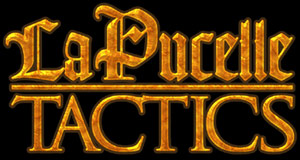

|
|
| Platform: | PlayStation 2 |
| Publisher: | Mastiff, LLC |
| Developer: | Nippon Ichi |
| Genre: | Turn-Based Strategy RPG |
| Format: | DVD-ROM |
| Release: |
Last year, Japanese developer Nippon Ichi produced an SRPG called Disgaea: Hour of Darkness, published by Atlus for the Playstation 2. The game featured a wealth of character classes, game mechanics, and approximately one-hundred hours of playtime. Now Nippon Ichi aims to follow up Disgaea's success with La Pucelle: Tactics. La Pucelle: Tactics is actually an older game than Disgaea and is known in Japan as La Pucelle: the Maiden of Light. The original Japanese release was in early 2002, and long-time import fans have been clamoring for a translation. Thanks to Mastiff, LLC, that dream has finally become a reality.
The story is set in a fairly humorous tone, with characters bearing names such as "Culotte" (Underpants in French), and Captain Homard (Lobster). In addition, the kingdom of Paprica where the game takes place, worships the Goddess Poitrine (Breast in French). The main character Prier (Pray) will also encounter such interesting groups as the Chocolat Squad and Escargot Group. Prier herself is an orphan whose parents died when she was very young, and raised in an orphanage until such a time as when she could take up the duty of being in the Holy defense force. Now a graduate, she rallies her troops together to start purging the land of its demons.
The game will utilize large, hand-drawn backgrounds and manga style graphics to envision the world of La Pucelle, and allow players to explore Paprica using three different kinds of maps. The world map allows players to guide Prier and her band from point to point, similar to the system of navigation found in Final Fantasy Tactics. From the world map, players can enter into field maps or area maps, depending on the situation. Field maps are where players will experience the majority of the storyline, while area maps are where parties do battle. Field maps are also where players will interact with the majority of NPCs and shops. When a player buys an item, it vanishes from the shop's inventory and players will have to come back later to find that item again. Occasionally, players will be asked to fill out a survey which will determined which items appear more often.
Area maps are where combat takes place. Players will deploy up to eight characters against their enemies from a portal, onto a grid-based tactical field. Here, players can use a variety of commands to subdue enemies, including the ability to combine attacks. Placing characters next to each other will allow them to execute combos, launching one attack after the other in rapid succession. Enemies will be able to do this as well, so players will need to keep an eye on where characters are placed when planning a strategy. Terrain in general will play an important role in the game; being on higher ground when attacking will yield more damage than attacking from a lower height.
In addition to regular combat, area maps also feature Dark Portals, which act similar to the Geo Panels found in Disgaea: Hour of Darkness. Dark Portals generate Dark Energy, which can weaken or strengthen a character depending on the kind of energy being produced. When a character stands on the Dark Portal, they will be under its influence, but also be able to guide its effects. Depending on which way a character is standing, dark energy will flow out and effect tiles in its path. If a Dark Portal is sealed using purification, any characters standing on the effected tiles will receive a substantial amount of damage; players can use this factor to their advantage, but it can also be the cause of untimely defeat.
If an area of more than 15 tiles becomes affected by dark energy and the portal is sealed through purification, a miracle occurs. Miracles can summon deities depending on what kind of dark energy was being generated. Two different kinds of dark energy can overlap to produce a completely new effect, and the rarer the effect produced, the more powerful the miracle that occurs. The deities summoned by this effect can heal Prier and her party, attack the enemy, and cause a variety of other phenomena on the battlefield.
Purification plays a vital role in the game. It can be used to seal Dark Portals, as well as convert enemy units into helping Prier's forces. It also allows players to refine items when sealing Dark Portals. When a portal is purified, some of the energy flows through the character's equipped items, raising their level. Players can improve items again and again in this way, though there are limits to how far an item can be improved. Up to 149 items can be carried at any given time and can be used to learn a variety of new abilities.
Players can also use purification to tame monsters. When a monster has been sufficiently defeated, players can choose to tame the monster rather than kill it; certain monsters such as bosses cannot be tamed however. When players do purify a monster, it will join their party as a regular member. Players will need to keep an eye on how happy their monsters are however, if a monster becomes too upset it will leave the party.
The game will feature over one-hundred hours of gameplay, and a tightly-woven story than that rivals Disgaea. Depending on the paths a player chooses, and objectives completed, multiple endings are also available. Combining humor, complex gameplay, and manga-style artwork; La Pucelle: Tactics may be what many SRPG fans are looking for. Developed by Nippon Ichi and published by Mastiff LLC, La Pucelle: Tactics will be released in North America this May. |
||||||||||||||||||||||||